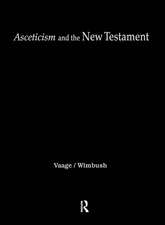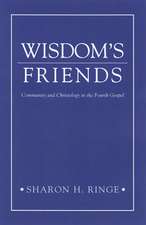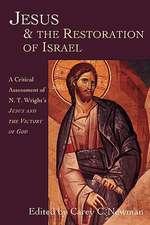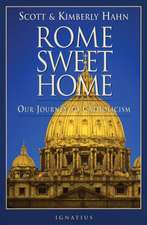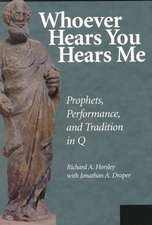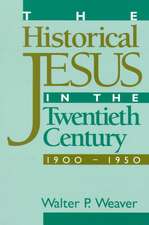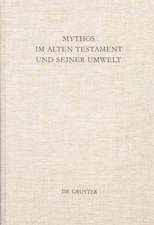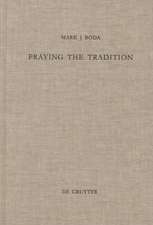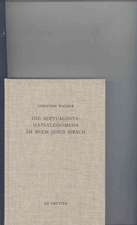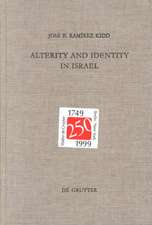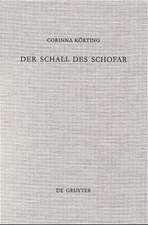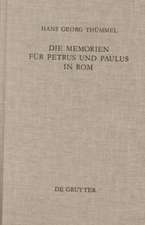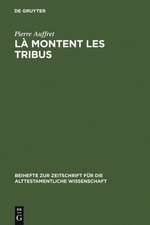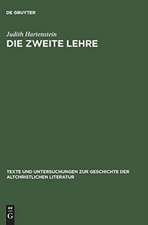Hail, Holy Queen: The Mother of God in the Word of God
Autor Scott Hahnen Limba Engleză Paperback – 31 aug 2006
In The Lamb's Supper, Catholic scholar and apologist Scott Hahn explored the relationship between the Book of Revelation and the Roman Catholic Mass, deftly clarifying the most subtle of theological points with analogies and anecdotes from everyday life. In Hail, Holy Queen, he employs the same accessible, entertaining style to demonstrate Mary's essential role in Christianity's redemptive message.
Most Christians know that the life of Jesus is foreshadowed throughout the Old Testament. Through a close examination of the Bible, as well as the work of both Catholic and Protestant scholars and clergy, Hahn brings to light the small but significant details showing that just as Jesus is the "New Adam," so Mary is the "New Eve." He unveils the Marian mystery at the heart of the Book of Revelation and reveals how it is foretold in the very first pages of the Book of Genesis and in the story of King David's monarchy, which speaks of a privileged place for the mother of the king.
Building on these scriptural and historical foundations, Hahn presents a new look at the Marian doctrines: Her Immaculate Conception, Perpetual Virginity, Assumption, and Coronation. As he guides modern-day readers through passages filled with mysteries and poetry, Hahn helps them rediscover the ancient art and science of reading the Scriptures and gain a more profound understanding of their truthfulness and relevance to faith and the practice of religion in the contemporary world.
Preț: 89.91 lei
Nou
Puncte Express: 135
Preț estimativ în valută:
17.20€ • 17.96$ • 14.24£
17.20€ • 17.96$ • 14.24£
Carte disponibilă
Livrare economică 14-28 martie
Preluare comenzi: 021 569.72.76
Specificații
ISBN-13: 9780385501699
ISBN-10: 0385501692
Pagini: 191
Dimensiuni: 140 x 210 x 14 mm
Greutate: 0.2 kg
Editura: IMAGE
ISBN-10: 0385501692
Pagini: 191
Dimensiuni: 140 x 210 x 14 mm
Greutate: 0.2 kg
Editura: IMAGE
Notă biografică
SCOTT HAHN, an internationally renowned Catholic lecturer and theologian, is professor of Biblical theology at the Franciscan University of Steubenville. He is the director of the Institute of Applied Biblical Studies and president of the St. Paul Center for Applied Biblical Theology. His books include A Father Who Keeps His Promises; Rome Sweet Home, coauthored with his wife, Kimberly; The Lamb's Supper; and Hail, Holy Queen, among others. He lives in Steubenville, Ohio, with his wife and their six children.
Extras
CHAPTER 1
My Type of Mother
THE LOVING LOGIC OF MARY'S MATERNITY
Mothers are the most difficult people to study. They elude our scrutiny. By nature and by definition, they are relational. They can be considered as mothers only in their relationship with their children. That is where they focus their attention, and that is where they would focus ours.
Nature keeps mother and child so close as to be almost indistinct as individuals through the first nine months of life. Their bodies are made for each other. During pregnancy, they share the same food, blood, and oxygen. After birth, nature places the child at the mother's breast for nourishment. The newborn's eyes can see only far enough to make eye contact with Mom. The newborn's ears can clearly hear the beating of the mother's heart and the high tones of the female voice. Nature has even made a woman's skin smoother than her husband's, the better to nestle with the sensitive skin of a baby. The mother, body and soul, points beyond herself, to her child.
Yet as close as nature keeps us to our mothers, they remain mysterious to their children. They remain as mysteries. In the words of G. K. Chesterton's Father Brown, "A thing can sometimes be too close to be seen."
As the Mother of God, Mary is the mother par excellence. So, as all mothers are elusive, she will be more so. As all mothers give of themselves, she will give more. As all mothers point beyond themselves, Mary will to a much greater degree.
A true mother, Mary considers none of her glories her own. After all, she points out, she is only doing God's bidding: "Behold, I am the handmaid of the Lord; let it be to me according to your word" (Lk 1:38). Even when she recognizes her superior gifts, she recognizes that they are gifts: "All generations will call me blessed" (Lk 1:48). For her part, Mary's own soul "magnifies" not herself but "the Lord" (Lk 1:46).
How, then, are we to approach this elusive subject, if she must always be relational? How can we begin to study this woman who always deflects attention away from herself and toward her Child?
Let's Get Metaphysical
To understand the Mother of God, we must begin with God. All Mariology, all Marian devotion, must begin with solid theology and firm credal faith. For all that Mary does, and all that she is, flows from her relationship with God and her correspondence to His divine plan. She is His mother. She is His spouse. She is His daughter. She is His handmaid. We cannot begin to know her if we do not, first, have clear notions about Him--about God, His providence, and His dealings with His people.
And that's not as easy as some people would lead us to believe. We, after all, are dependent upon language that engages our imagination, that makes invisible things understandable by comparing them to things that we see: God is boundless, like the sky; He is illuminating, like a fire; He is everywhere, like the wind. Or we contrast God's qualities with our own: we are finite, but He is infinite; we are limited in our power, but He is all-powerful.
Analogy and contrast are as far as most people go in their consideration of God--and these are true, as far as they go. Yet they don't go far enough. God is pure spirit, and all our earthly analogies fall far short of describing Him as He really is.
Theology is the way we approach God on His terms rather than our own. Thus, though there's no easy way of going about it, we can't go deep in our faith unless we're willing to take on the task of theology to some degree.
The ultimate truth about God cannot be dependent on anything other than God. We cannot define God in terms of something contingent, as in analogies with creation. God does not depend upon creation for His identity. So even His title of creator is something relative and not absolute. Though He is eternal and He is the creator, He is not the eternal creator. Creation is something that takes place in time, and God transcends time. So, though creation is something God does, it does not define Who He is. The same goes for redemption and sanctification. Though God is redeemer and sanctifier, these titles do not define His eternal identity, but rather certain of His works. The terms "creator," "redeemer," "lawgiver," and "sanctifier" are all dependent upon the world--upon something that needs to be created, redeemed, ruled, and sanctified.
What's-His-Name
Then how can we know God as He is? Primarily because He has revealed Himself to us. He has told us His eternal identity. His name. At the end of Saint Matthew's gospel (28:19), Jesus commands His disciples to baptize "in the name" of the Blessed Trinity: the Father, the Son, and the Holy Spirit. Notice that He does not speak of these as three titles, but as a single name. In the culture of ancient Israel, one's name was equivalent to one's identity. This single name, then, reveals Who God is from all eternity. He is Father, Son, and Holy Spirit.
Now, you might reasonably object, those titles are dependent on creation. Are not "Father" and "Son" mere analogies with earthly familial roles?
No. In fact, that's precisely backwards. Rather, the earthly roles of father and son are living metaphors for something divine and eternal. God Himself is, somehow, eternally, perfectly a family. Pope John Paul II expressed this well: "God in His deepest mystery is not a solitude, but a family, since He has in Himself fatherhood, sonship, and the essence of the family, which is love."
Did you catch that? God, then, is not like a family; God is a family. From eternity, God alone possesses the essential attributes of a family, and the Trinity alone possesses them in their perfection. Earthly households have these attributes, but imperfectly.
Divinity Is As Divinity Does
Yet God's transcendence does not leave creation completely without a clue. Creation does tell us something about its creator. Artwork always reveals a hint of the character of the artist. So we can learn more about Who God is by observing what He does.
The process works in reverse as well. We can learn more about creation, redemption, and the works of God by studying them in the light of His self-revelation. Because the Trinity reveals the deepest dimension of Who God is, it also reveals the deepest meaning of what God does. The mystery of the Trinity is "the central mystery of Christian faith and life," says the Catechism of the Catholic Church (no. 234). "It is the mystery of God in Himself. It is therefore the source of all the other mysteries of faith, the light that enlightens them." Thus, our understanding of God as family should also profoundly affect our understanding of all His works. In everything that exists, we may discern--with the eyes of faith--a familial purpose, what the theological tradition calls "the footprints of the Trinity."
Reflection on the mystery of God and the mysteries of creation, then, becomes mutually enhancing. Says the Catechism: "God's works reveal Who He is in Himself; the mystery of His inmost being enlightens our understanding of all His works. So it is, analogously, among human persons. A person discloses himself in his actions, and the better we know a person, the better we understand his actions" (no. 236).
Traces of Love, Long Ago
We catch glimpses of God not just in the world but also--and especially--in the scriptures, which are uniquely inspired by God to convey His truth. The Catechism goes on to explain that God has revealed "His Trinitarian being" explicitly in the New Testament, but also left "traces . . . in His Revelation throughout the Old Testament" (no. 237).
The whole of the scriptures, then, can be viewed as the story of God's preparation for, and completion of, His greatest work: His definitive self-revelation in Jesus Christ. Saint Augustine said that the New Testament is concealed in the Old, and the Old is revealed in the New. For all history was the world's preparation for the moment when the Word was made flesh, when God became a human child in the womb of a young virgin from Nazareth.
Like Jesus Christ, the Bible is unique. For it is the only book that can truly claim to have both human authors and a divine author, the Holy Spirit. Jesus Christ is the Word of God incarnate, fully divine yet fully human--like all of us, except without sin. The Bible is the Word of God inspired, fully divine yet fully human--like any other book, except without error. Both Christ and scripture are given, said the Second Vatican Council, "for the sake of our salvation" (Dei Verbum 11).
So when we read the Bible, we need to read it on two levels at once. We read the Bible in a literal sense as we read any other human literature. But we read it also in a spiritual sense, searching out what the Holy Spirit is trying to tell us through the words (see Catechism, nos. 115-19).
We do this in imitation of Jesus, because this is the way He read the scriptures. He referred to Jonah (Mt 12:39), Solomon (Mt 12:42), the temple (Jn 2:19), and the brazen serpent (Jn 3:14) as "signs" that prefigured Him. We see in Luke's gospel, as our Lord comforted the disciples on the road to Emmaus, that "beginning with Moses and all the prophets, He interpreted to them what referred to Him in all the scriptures" (Lk 24:27). After this spiritual reading of the Old Testament, we are told, the disciples' hearts burned within them.
What ignited this fire in their hearts? Through the scriptures, Jesus had initiated His disciples into a world that reached beyond their senses. A good teacher, God introduced the unfamiliar in terms of the familiar. Indeed, He had created the familiar with this end in mind, fashioning the persons and institutions that would best prepare us for the coming of Christ and the glories of His kingdom.
Learning to Type
The first Christians followed their Master in reading the Bible this way. In the letter to the Hebrews, the Old Testament tabernacle and its rituals are described as "types and shadows of heavenly realities" (8:5), and the law as a "shadow of the good things to come" (10:1). Saint Peter, in turn, noted that Noah and his family "were saved through water," and that "this prefigured baptism, which saves you now" (1 Pt 3:20-21). Peter's word translated as "prefigured" is actually the Greek word for "typify," or "make a type." The apostle Paul, for his part, described Adam as a "type" of Jesus Christ (Rom 5:14).
So what is a type? A type is a real person, place, thing, or event in the Old Testament that foreshadows something greater in the New Testament. From "type" we get the word "typology," the study of Christ's foreshadowing in the Old Testament (see Catechism, 128-130).
Again, we must emphasize that types are not fictional symbols. They are literally true historical details. When Saint Paul interpreted the story of Abraham's sons as "an allegory" (Gal 4:24), for example, he was not suggesting that the story never really happened; he was affirming it as history, but as history with a place in God's plan, history whose meaning was clear only after its eventual fulfillment.
Typology unveils more than the person of Christ; it also tells us about heaven, the Church, the apostles, the Eucharist, the places of Jesus' birth and death, and the person of Jesus' mother. From the first Christians we learn that the Jerusalem temple foreshadowed the heavenly dwelling of the saints in glory (2 Cor 5:1-2; Rev 21:9-22); that Israel prefigured the Church (Gal 6:16); that the twelve Old Testament patriarchs prefigured the twelve New Testament apostles (Lk 22:30); and that the ark of the covenant was a type of the Blessed Virgin Mary (Rev 11:19; 12:1-6,13-17).
In addition to Old Testament types explicitly discussed in the New Testament, there are many more that are implicit but obvious. For example, Saint Joseph's role in the early life of Jesus clearly follows the patriarch Joseph's role in the early life of Israel. The two men share the same name; both are described as "righteous," or "just"; both receive revelations in dreams; both find themselves exiled to Egypt; and both arrive on the scene in order to prepare the way for a greater event--in the patriarch Joseph's case, the exodus led by Moses, the Deliverer; in Saint Joseph's case, the redemption brought about by Jesus, the Redeemer.
Marian types abound in the Old Testament. We find Mary prefigured in Eve, the mother of all the living; in Sarah, the wife of Abraham, who conceived her child miraculously; in the queen mother of Israel's monarchy, who interceded with the king on behalf of the people of the land; and in many other places, in many other ways (for example, Hannah and Esther). The type addressed most explicitly in the New Testament, the ark of the covenant, I will discuss in greater detail in its own chapter. Here I will merely point out that, as the ancient ark was made to bear the old covenant, so the Virgin Mary was created to bear the new covenant.
Family Affairs
It is that new covenant, borne into the world by the Blessed Virgin Mary, that has made all the difference in our lives--in my life and yours--and in human history. For covenants mark all the decisive encounters between God and man. God's relationship with Israel was defined by a covenant, as were His relationships with Adam, Noah, Abraham, Moses, and David. Jesus Himself spoke of His redemptive sacrifice as the new covenant in His blood (Lk 22:20).
We hear those words in the Eucharistic prayer at every Mass, but do we ever pause to ask: what is a covenant? This is a most crucial question, one that brings us to the heart of Christian faith and life. In fact, it brings us to the very heart of God.
What is a covenant? The question leads us back to the primal reality we discussed earlier in this chapter: the family. In the ancient Near East, a covenant was a sacred kinship bond based on a solemn oath that brought someone into a family relationship with another person or tribe. When God made His covenants with Adam, Noah, Abraham, Moses, and David, He was gradually inviting a wider circle of people into His family: first a couple, then a family, then a nation, and eventually the world.
All of those covenants failed, however, because of man's unfaithfulness and sin. God remained constantly faithful; Adam did not, and neither did Moses, neither did David. In fact, sacred history leads us to conclude that only God keeps His covenant promises. How, then, could mankind fulfill the human end of a covenant in a way that would last forever? That would require a man to be sinless and as constant as God. Thus, for the new and everlasting covenant, God became man in Jesus Christ, and He established the covenant by which we become part of His family: the family of God.
This means more than mere fellowship with God. For "God in His deepest mystery is . . . a family." God Himself is Father, Son, and the Spirit of Love--and Christians are drawn up into the life of that family. In baptism we are identified with Christ, baptized in the Trinitarian name of God; we take on His family name, and thus we become sons in the Son. We are taken up into the very life of the Trinity, where we may live in love forever. If God is family, heaven is home; and with Jesus, heaven has come to earth.
My Type of Mother
THE LOVING LOGIC OF MARY'S MATERNITY
Mothers are the most difficult people to study. They elude our scrutiny. By nature and by definition, they are relational. They can be considered as mothers only in their relationship with their children. That is where they focus their attention, and that is where they would focus ours.
Nature keeps mother and child so close as to be almost indistinct as individuals through the first nine months of life. Their bodies are made for each other. During pregnancy, they share the same food, blood, and oxygen. After birth, nature places the child at the mother's breast for nourishment. The newborn's eyes can see only far enough to make eye contact with Mom. The newborn's ears can clearly hear the beating of the mother's heart and the high tones of the female voice. Nature has even made a woman's skin smoother than her husband's, the better to nestle with the sensitive skin of a baby. The mother, body and soul, points beyond herself, to her child.
Yet as close as nature keeps us to our mothers, they remain mysterious to their children. They remain as mysteries. In the words of G. K. Chesterton's Father Brown, "A thing can sometimes be too close to be seen."
As the Mother of God, Mary is the mother par excellence. So, as all mothers are elusive, she will be more so. As all mothers give of themselves, she will give more. As all mothers point beyond themselves, Mary will to a much greater degree.
A true mother, Mary considers none of her glories her own. After all, she points out, she is only doing God's bidding: "Behold, I am the handmaid of the Lord; let it be to me according to your word" (Lk 1:38). Even when she recognizes her superior gifts, she recognizes that they are gifts: "All generations will call me blessed" (Lk 1:48). For her part, Mary's own soul "magnifies" not herself but "the Lord" (Lk 1:46).
How, then, are we to approach this elusive subject, if she must always be relational? How can we begin to study this woman who always deflects attention away from herself and toward her Child?
Let's Get Metaphysical
To understand the Mother of God, we must begin with God. All Mariology, all Marian devotion, must begin with solid theology and firm credal faith. For all that Mary does, and all that she is, flows from her relationship with God and her correspondence to His divine plan. She is His mother. She is His spouse. She is His daughter. She is His handmaid. We cannot begin to know her if we do not, first, have clear notions about Him--about God, His providence, and His dealings with His people.
And that's not as easy as some people would lead us to believe. We, after all, are dependent upon language that engages our imagination, that makes invisible things understandable by comparing them to things that we see: God is boundless, like the sky; He is illuminating, like a fire; He is everywhere, like the wind. Or we contrast God's qualities with our own: we are finite, but He is infinite; we are limited in our power, but He is all-powerful.
Analogy and contrast are as far as most people go in their consideration of God--and these are true, as far as they go. Yet they don't go far enough. God is pure spirit, and all our earthly analogies fall far short of describing Him as He really is.
Theology is the way we approach God on His terms rather than our own. Thus, though there's no easy way of going about it, we can't go deep in our faith unless we're willing to take on the task of theology to some degree.
The ultimate truth about God cannot be dependent on anything other than God. We cannot define God in terms of something contingent, as in analogies with creation. God does not depend upon creation for His identity. So even His title of creator is something relative and not absolute. Though He is eternal and He is the creator, He is not the eternal creator. Creation is something that takes place in time, and God transcends time. So, though creation is something God does, it does not define Who He is. The same goes for redemption and sanctification. Though God is redeemer and sanctifier, these titles do not define His eternal identity, but rather certain of His works. The terms "creator," "redeemer," "lawgiver," and "sanctifier" are all dependent upon the world--upon something that needs to be created, redeemed, ruled, and sanctified.
What's-His-Name
Then how can we know God as He is? Primarily because He has revealed Himself to us. He has told us His eternal identity. His name. At the end of Saint Matthew's gospel (28:19), Jesus commands His disciples to baptize "in the name" of the Blessed Trinity: the Father, the Son, and the Holy Spirit. Notice that He does not speak of these as three titles, but as a single name. In the culture of ancient Israel, one's name was equivalent to one's identity. This single name, then, reveals Who God is from all eternity. He is Father, Son, and Holy Spirit.
Now, you might reasonably object, those titles are dependent on creation. Are not "Father" and "Son" mere analogies with earthly familial roles?
No. In fact, that's precisely backwards. Rather, the earthly roles of father and son are living metaphors for something divine and eternal. God Himself is, somehow, eternally, perfectly a family. Pope John Paul II expressed this well: "God in His deepest mystery is not a solitude, but a family, since He has in Himself fatherhood, sonship, and the essence of the family, which is love."
Did you catch that? God, then, is not like a family; God is a family. From eternity, God alone possesses the essential attributes of a family, and the Trinity alone possesses them in their perfection. Earthly households have these attributes, but imperfectly.
Divinity Is As Divinity Does
Yet God's transcendence does not leave creation completely without a clue. Creation does tell us something about its creator. Artwork always reveals a hint of the character of the artist. So we can learn more about Who God is by observing what He does.
The process works in reverse as well. We can learn more about creation, redemption, and the works of God by studying them in the light of His self-revelation. Because the Trinity reveals the deepest dimension of Who God is, it also reveals the deepest meaning of what God does. The mystery of the Trinity is "the central mystery of Christian faith and life," says the Catechism of the Catholic Church (no. 234). "It is the mystery of God in Himself. It is therefore the source of all the other mysteries of faith, the light that enlightens them." Thus, our understanding of God as family should also profoundly affect our understanding of all His works. In everything that exists, we may discern--with the eyes of faith--a familial purpose, what the theological tradition calls "the footprints of the Trinity."
Reflection on the mystery of God and the mysteries of creation, then, becomes mutually enhancing. Says the Catechism: "God's works reveal Who He is in Himself; the mystery of His inmost being enlightens our understanding of all His works. So it is, analogously, among human persons. A person discloses himself in his actions, and the better we know a person, the better we understand his actions" (no. 236).
Traces of Love, Long Ago
We catch glimpses of God not just in the world but also--and especially--in the scriptures, which are uniquely inspired by God to convey His truth. The Catechism goes on to explain that God has revealed "His Trinitarian being" explicitly in the New Testament, but also left "traces . . . in His Revelation throughout the Old Testament" (no. 237).
The whole of the scriptures, then, can be viewed as the story of God's preparation for, and completion of, His greatest work: His definitive self-revelation in Jesus Christ. Saint Augustine said that the New Testament is concealed in the Old, and the Old is revealed in the New. For all history was the world's preparation for the moment when the Word was made flesh, when God became a human child in the womb of a young virgin from Nazareth.
Like Jesus Christ, the Bible is unique. For it is the only book that can truly claim to have both human authors and a divine author, the Holy Spirit. Jesus Christ is the Word of God incarnate, fully divine yet fully human--like all of us, except without sin. The Bible is the Word of God inspired, fully divine yet fully human--like any other book, except without error. Both Christ and scripture are given, said the Second Vatican Council, "for the sake of our salvation" (Dei Verbum 11).
So when we read the Bible, we need to read it on two levels at once. We read the Bible in a literal sense as we read any other human literature. But we read it also in a spiritual sense, searching out what the Holy Spirit is trying to tell us through the words (see Catechism, nos. 115-19).
We do this in imitation of Jesus, because this is the way He read the scriptures. He referred to Jonah (Mt 12:39), Solomon (Mt 12:42), the temple (Jn 2:19), and the brazen serpent (Jn 3:14) as "signs" that prefigured Him. We see in Luke's gospel, as our Lord comforted the disciples on the road to Emmaus, that "beginning with Moses and all the prophets, He interpreted to them what referred to Him in all the scriptures" (Lk 24:27). After this spiritual reading of the Old Testament, we are told, the disciples' hearts burned within them.
What ignited this fire in their hearts? Through the scriptures, Jesus had initiated His disciples into a world that reached beyond their senses. A good teacher, God introduced the unfamiliar in terms of the familiar. Indeed, He had created the familiar with this end in mind, fashioning the persons and institutions that would best prepare us for the coming of Christ and the glories of His kingdom.
Learning to Type
The first Christians followed their Master in reading the Bible this way. In the letter to the Hebrews, the Old Testament tabernacle and its rituals are described as "types and shadows of heavenly realities" (8:5), and the law as a "shadow of the good things to come" (10:1). Saint Peter, in turn, noted that Noah and his family "were saved through water," and that "this prefigured baptism, which saves you now" (1 Pt 3:20-21). Peter's word translated as "prefigured" is actually the Greek word for "typify," or "make a type." The apostle Paul, for his part, described Adam as a "type" of Jesus Christ (Rom 5:14).
So what is a type? A type is a real person, place, thing, or event in the Old Testament that foreshadows something greater in the New Testament. From "type" we get the word "typology," the study of Christ's foreshadowing in the Old Testament (see Catechism, 128-130).
Again, we must emphasize that types are not fictional symbols. They are literally true historical details. When Saint Paul interpreted the story of Abraham's sons as "an allegory" (Gal 4:24), for example, he was not suggesting that the story never really happened; he was affirming it as history, but as history with a place in God's plan, history whose meaning was clear only after its eventual fulfillment.
Typology unveils more than the person of Christ; it also tells us about heaven, the Church, the apostles, the Eucharist, the places of Jesus' birth and death, and the person of Jesus' mother. From the first Christians we learn that the Jerusalem temple foreshadowed the heavenly dwelling of the saints in glory (2 Cor 5:1-2; Rev 21:9-22); that Israel prefigured the Church (Gal 6:16); that the twelve Old Testament patriarchs prefigured the twelve New Testament apostles (Lk 22:30); and that the ark of the covenant was a type of the Blessed Virgin Mary (Rev 11:19; 12:1-6,13-17).
In addition to Old Testament types explicitly discussed in the New Testament, there are many more that are implicit but obvious. For example, Saint Joseph's role in the early life of Jesus clearly follows the patriarch Joseph's role in the early life of Israel. The two men share the same name; both are described as "righteous," or "just"; both receive revelations in dreams; both find themselves exiled to Egypt; and both arrive on the scene in order to prepare the way for a greater event--in the patriarch Joseph's case, the exodus led by Moses, the Deliverer; in Saint Joseph's case, the redemption brought about by Jesus, the Redeemer.
Marian types abound in the Old Testament. We find Mary prefigured in Eve, the mother of all the living; in Sarah, the wife of Abraham, who conceived her child miraculously; in the queen mother of Israel's monarchy, who interceded with the king on behalf of the people of the land; and in many other places, in many other ways (for example, Hannah and Esther). The type addressed most explicitly in the New Testament, the ark of the covenant, I will discuss in greater detail in its own chapter. Here I will merely point out that, as the ancient ark was made to bear the old covenant, so the Virgin Mary was created to bear the new covenant.
Family Affairs
It is that new covenant, borne into the world by the Blessed Virgin Mary, that has made all the difference in our lives--in my life and yours--and in human history. For covenants mark all the decisive encounters between God and man. God's relationship with Israel was defined by a covenant, as were His relationships with Adam, Noah, Abraham, Moses, and David. Jesus Himself spoke of His redemptive sacrifice as the new covenant in His blood (Lk 22:20).
We hear those words in the Eucharistic prayer at every Mass, but do we ever pause to ask: what is a covenant? This is a most crucial question, one that brings us to the heart of Christian faith and life. In fact, it brings us to the very heart of God.
What is a covenant? The question leads us back to the primal reality we discussed earlier in this chapter: the family. In the ancient Near East, a covenant was a sacred kinship bond based on a solemn oath that brought someone into a family relationship with another person or tribe. When God made His covenants with Adam, Noah, Abraham, Moses, and David, He was gradually inviting a wider circle of people into His family: first a couple, then a family, then a nation, and eventually the world.
All of those covenants failed, however, because of man's unfaithfulness and sin. God remained constantly faithful; Adam did not, and neither did Moses, neither did David. In fact, sacred history leads us to conclude that only God keeps His covenant promises. How, then, could mankind fulfill the human end of a covenant in a way that would last forever? That would require a man to be sinless and as constant as God. Thus, for the new and everlasting covenant, God became man in Jesus Christ, and He established the covenant by which we become part of His family: the family of God.
This means more than mere fellowship with God. For "God in His deepest mystery is . . . a family." God Himself is Father, Son, and the Spirit of Love--and Christians are drawn up into the life of that family. In baptism we are identified with Christ, baptized in the Trinitarian name of God; we take on His family name, and thus we become sons in the Son. We are taken up into the very life of the Trinity, where we may live in love forever. If God is family, heaven is home; and with Jesus, heaven has come to earth.
Descriere
Hahn demonstrates Mary's essential role in Christianity's redemptive message. He unveils the Marian mystery at the heart of the Book of Revelation and reveals how it is foretold in the very first pages of the Book of Genesis and in the story of King David's monarchy.

